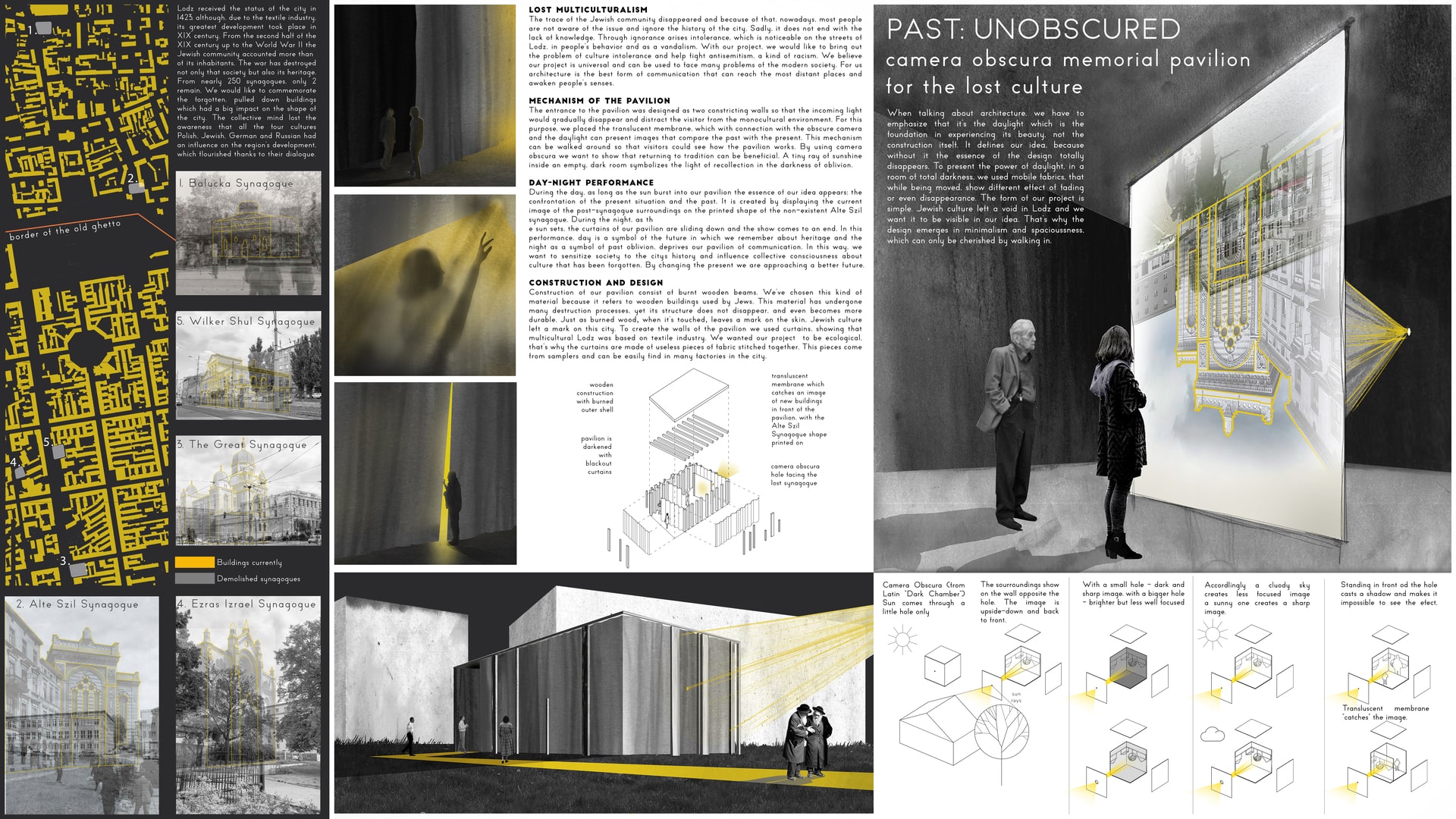Project Description
LOST MULTICULTURALISM The trace of the Jewish community disappeared and because of that, nowadays, most people are not aware of the issue and ignore the history of the city. Sadly, it does not end with the lack of knowledge. Through ignorance arises intolerance, which is noticeable on the streets of Lodz, in people’s behavior and as a vandalism. With our project, we would like to bring out the problem of culture intolerance and help fight antisemitism, a kind of racism. We believe our project is universal and can be used to face many problems of the modern society. For us architecture is the best form of communication that can reach the most distant places and awaken people’s senses. LODZ Lodz received the status of the city in 1423, although, due to the textile industry, its greatest development took place in XIX century. From the second half of the XIX century up to the World War II the Jewish community accounted more than ⅓ of its inhabitants. The war has destroyed not only that society but also its heritage. From nearly 250 synagogues, only 2 remain. We would like to commemorate the forgotten, pulled down buildings which had a big impact on the shape of the city. The collective mind lost the awareness that all the four cultures Polish, Jewish, German and Russian had an influence on the region’s development, which flourished thanks to their dialogue. MECHANISM OF THE PAVILION The entrance to the pavilion was designed as two constricting walls so that the incoming light would gradually disappear and distract the visitor from the monocultural environment. For this purpose, we placed the translucent membrane, which with connection with the obscure camera and the daylight can present images that compare the past with the present. This mechanism can be walked around so that visitors could see how the pavilion works. By using camera obscura we want to show that returning to tradition can be beneficial. A tiny ray of sunshine inside an empty, dark room symbolizes the light of recollection in the darkness of oblivion. DAYLIGHT When talking about architecture, we have to emphasize that it’s the daylight which is the foundation in experiencing its beauty, not the construction itself. It defines our idea, because without it the essence of the design totally disappears. To present the power of daylight, in a room of total darkness, we used mobile fabrics, that while being moved, show different effect of fading or even disappearance. The form of our project is simple. Jewish culture left a void in Lodz and we want it to be visible in our idea. That’s why the design emerges in minimalism and spacioussness, which can only be cherished by walking in. CONSTRUCTION AND DESIGN Construction of our pawilon consist of burnt wooden beams. We’ve chosen this kind of material because it refers to wooden buildings used by Jews. This material has undergone many destruction processes, yet its structure does not disappear, and even becomes more durable. Just as burned wood, when it’s touched, leaves a mark on the skin, Jewish culture left a mark on this city. To create the walls of the pavilion we used curtains, showing that multicultural Lodz was based on textile industry. We wanted our project to be ecological, that’s why the curtains are made of useless pieces of fabric stitched together. This pieces come from samplers and can be easily find in many factories in the city. DAY NIGHT PERFORMANCE During the day, as long as the sun burst into our pavilion the essence of our idea appears: the confrontation of the present situation and the past. It is created by displaying the current image of the post-synagogue surroundings on the printed shape of the non-existent Alte Szil synagogue. During the night, as the sun sets, the curtains of our pavilion are sliding down and the show comes to an end. In this performance, day is a symbol of the future in which we remember about heritage and the night as a symbol of past oblivion, deprives our pavilion of communication. In this way, we want to sensitize society to the city's history and influence collective consciousness about culture that has been forgotten. By changing the present we are approaching a better future.
